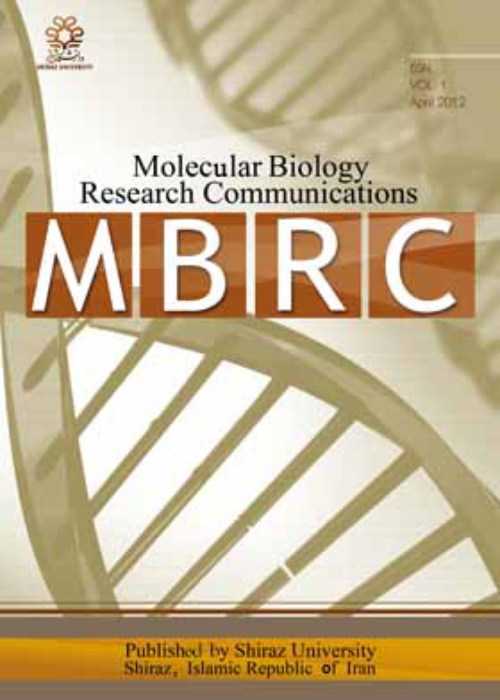فهرست مطالب
Molecular Biology Research Communications
Volume:7 Issue: 4, Dec 2018
- تاریخ انتشار: 1397/12/21
- تعداد عناوین: 4
-
-
Pages 153-163Ethylene response factor proteins are important for regulating gene expression under different stresses. Different isoforms for ERF have previously isolated from bread wheat (Triticum aestivum L.) and related genera and called from TaERF1 to TaERF5. We isolated, cloned and molecular characterized a novel one based on TdERF1, an isoform in durum wheat (Triticum turgidum L.) and called TaERF6. Its cDNA was synthesized, sequenced and compared with genomic sequence to figure out intron and exon regions and determine coding sequence region. The length of TdERF1 gene was 1939 bp and cDNA was 1065 bp including two exons, the first one 259 bp and the second one 806 bp separated by a 874 bp intron with a 111 bp 5'-UTR (untranslated region) and 401 bp 3'-UTR. TaERF6 encodes a 353 amino acids protein with nearly 99% identity to TdERF1. Hydrophobic cluster analysis revealed an N-terminal hydrophobic domain contains a highly conserved motif with the consensus sequence of M [C/L/Y] [G/R] [G/R/P] [A/G/V/L/R] [I/L/R/S/P/Q] [L/I/R/H] and hydrophobic clusters in AP2/ERF domain of which tends to form b-sheet. Three monopartite nuclear localization signals also identified in TaERF6 that play important role in getting back into the nucleus. The results showed several putative phosphorylation sites in TaERF6 that a motif from residues 246 to 266, the CMVII-4 motif, was predicted to phosphorylate by different kinase proteins and play important roles in TaERF6 function. Phylogenetic analysis showed 7 clusters (I to VII) and 10 subclusters according to their relatedness in Poaceae family.Keywords: Hydrophobic cluster analysis, Phosphorylation sites, Phylogenetic, Poaceae
-
Pages 165-172The aim of this study is to identify, clone and express a Mycobacterium avium subsp. paratuberculosis specific immunogenic antigen candidate, in order to develop better reagents for diagnosis and vaccines for the protection of the host. Therefore, MAP2191 gene (a member of MAPmce5 operon) from MAP, was isolated and characterized by Bioinformatics tools and in vitro experiments. Then, a novel Mce-whole protein encoded by MAP2191 gene was amplified and sub-cloned into E. coli. We tried to express the Mce/whole protein in different condition along with a positive expression control (pET28a-Mce/truncated plasmid that we know express well), to ensure that nothing is wrong regarding culture/induction condition. The level of the recombinant protein expression was analyzed by means of SDS-PAGE and Western blotting. Western blot analysis toward full-length MAP2191 protein and its truncation only demonstrated Mce/truncated protein. The concurrence of in-silico prediction of primary structure of MAP2191 protein results along with experimental results confirmed that expression of Mce/whole protein was affected by the hydrophobicity nature of this protein. Our data support the hypothesis that the presence of hydrophobic regions in protein structure can influence the level of recombinant protein expression. This stresses the importance of gene selection and the protein sequence checking of the hydrophobic content in any protein purification project in order to achieve a large amount of desirable proteins.Keywords: Johne's disease, Control, mce gene, MAP2191, Hydrophobicity
-
Pages 173-179Coronary artery disease (CAD) is a common health problem with a high rate of disability and death. Dyslipidemia and altered metabolism of Apo-lipoproteins are involved in the CAD pathogenesis. The current study investigated two common polymorphisms (rs429358 and rs7412) and promoter DNA methylation status of APOE in the Iranian CAD patients and control subjects. Two hundred angiographically documented CAD patients and 200 control subjects were included in the study. The APOE polymorphism analysis was done by PCR-RFLP technique and DNA methylation status was evaluated by methylation specific PCR. The assay of lipid levels was conducted using standard colorimetric protocols.Results indicated that the frequency of ε3/ε4 and ε2/ε3 genotypes was significantly more common in CAD group compared with control group. Relative to wild type genotype (ε3/ε3), CAD patients with ε3/ε4 and ε2/ε3 genotypes displayed significantly higher concentration of total-cholesterol and LDL-cholesterol. The frequency of DNA methylation of APOE was similar between the two studied groups. However, the methylation frequency of APOE gene was significantly higher in triple stenotic vessels relative to single stenotic vessels (P=0.032). In conclusion The present study indicated that the rs429358 and rs7412 polymorphisms are significantly risk factors for development and severity of CAD. Also, APOE methylation status may be involved in the severity but not in the development of CAD.Keywords: Coronary artery disease_Polymorphism_Methylation_Apo-lipoprotein E
-
Pages 181-186In India, mutations in Cytochrome P450 (CYP1B1) are a predominant cause of not only primary congenital glaucoma (PCG) but also involved in primary open angle glaucoma (POAG) and juvenile onset glaucoma (JOAG). After ethical clearance, 100 POAG patients, 30 primary angle closure glaucoma (PACG) patients and 130 ethnically matched controls were recruited in this study. Genomic DNA was isolated from the blood and screened for p.Arg368His mutation in CYP1B1 by polymerase chain reaction-restriction fragment length polymorphism (PCR-RFLP). On PCR-RFLP, 10/100 cases (10%) were found positive for Arg368His mutation. In North Indian POAG cases studied, p.Arg368His mutation was found only in heterozygous state. The frequency of p.Arg368His CYP1B1 mutation in heterozygote state (10.0%) observed in our study in North Indian POAG patients is the highest in comparison to frequency observed in other ethnic groups from Southern and Eastern India.Keywords: North Indian, POAG, p.Arg368His, CYP1B1


